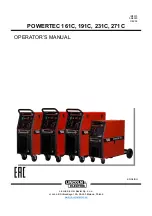
6
PHYSICAL AND SAFETY PROPERTIES OF GASES
a)
DO NOT use oxygen to refresh air.
There is often a temptation to use
oxygen to ‘sweeten’ air whilst welding or cutting operations are being
carried out in confined spaces. Large amounts of oxygen can be released
locally in a short time from gas cylinders under pressure. In one situation
where this was done, hot work in the form of flame cutting was carried out
with a subsequent ignition of worker’s clothes and fatal burns.
b)
TAKE CARE in confined spaces
. Do not leave blowpipes or hoses
connected to the supply gases within confined spaces overnight or during
work breaks. Slow leaks can result in very hazardous situations, with
possible fire and explosion on re-ignition of the blowpipe.
c)
VENTILATE confined spaces.
In flame cutting not all of the oxygen
released from the cutting nozzle is necessarily used in cutting. In confined
spaces this may result in a dangerous increase in oxygen content in the air,
pointing to the need for adequate ventilation in such situations.
d)
DO NOT use oxygen as a substitute for compressed air.
There are
many examples of this situation where oxygen has been used, such as in
cleaning, resulting in serious and fatal accidents due to fire or explosion from
spontaneous ignition. NEVER use oxygen to start engines, drive air tools
etc.
e)
DO NOT use oxygen or compressed air to dust off clothes.
Clothes
can become readily flammable and even self-igniting through oxygen
enrichment.
f)
DO NOT kink pressure hosing.
Kinking or nipping hose to interrupt gas
flows or whilst changing torches is a very dangerous practice. Gas can still
bleed through the system, or more seriously, escape rapidly should the hose
rupture or the operator lose their grip.
g)
The oxygen cylinder once it is empty can devalued and the cylinder
recycled at a scrap metal merchant.
DO NOT USE BRAZEN 3000 IF THE RUBBER O-RING IS MISSING
OR DAMAGED IN THE REGULATORS






































